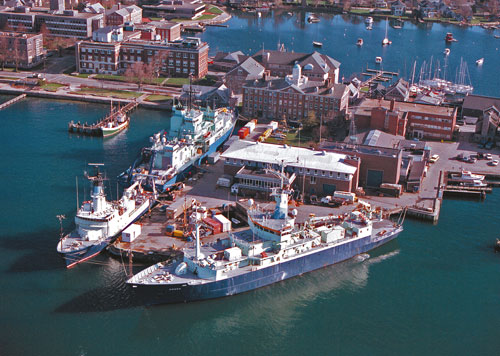 Newport’s research community leapt forward last month when the National Oceanic and Atmospheric Administration signed a lease with the Port of Newport for a new facility, paid for by $19.5 million in lottery-backed bonds and $24.8 million in revenue bonds issued by the port.
Newport’s research community leapt forward last month when the National Oceanic and Atmospheric Administration signed a lease with the Port of Newport for a new facility, paid for by $19.5 million in lottery-backed bonds and $24.8 million in revenue bonds issued by the port.
 |
Iselin Marine Facility at Woods HolePHOTO BY WOODS HOLE OCEANOGRAPHIC INSTITUTION |
Add the facilities in Newport and Corvallis together, and Oregon is home to the third-largest ocean research community in the U.S., with a budget of about $120 million, says George Boehlert, director of OSU’s Hatfield Marine Science Center in Newport. The coastal town of about 10,000 is a rising star in ocean research, behind only the Scripps Institution of Oceanography at the University of California in San Diego and Woods Hole, Mass., a Cape Cod village world-famous for marine research.
Newport’s research community leapt forward last month when the National Oceanic and Atmospheric Administration signed a lease with the Port of Newport for a new facility, paid for by $19.5 million in lottery-backed bonds and $24.8 million in revenue bonds issued by the port. The facility’s economic impact is estimated to be $19 million per year, plus 50 to 100 construction jobs and a smaller number of NOAA jobs. Port manager Don Mann says building up the science sector will create high-paying jobs and diversify the economy in the long run. “We keep saying we want to be the Woods Hole of the West Coast,” he says.
Newport hosts researchers from OSU and at least seven federal agencies, making it more like Woods Hole’s multi-institutional community than San Diego’s university-based Scripps. Woods Hole is a coastal town with a small population that regularly swells with tourists, fishermen, second homeowners and oceanographers — much like Newport.
But Newport can’t exactly replicate the Woods Hole path to pre-eminence. Woods Hole’s science community developed after the U.S. Commission of Fish and Fisheries (now the National Marine Fisheries Service) was established in 1871, and started attracting marine biologists to the area who established more laboratories. The Woods Hole Oceanographic Institution, the largest of the 73 marine science firms in Cape Cod and its biggest employer with about 1,000 employees and a research budget of $129 million, was established in 1930. Woods Hole is also bolstered by its proximity to a host of top-rated universities.
One tangle in building an ocean research hub is that oceanographers can now do their work without the sea by monitoring satellite transmissions and even operating vessels remotely. Quick ocean access was a big factor in NOAA’s decision to move from Seattle to Newport, where the 30-minute cruise to the Pacific is a vast improvement over a lengthy slog through locks and Puget Sound. But a May 2008 report commissioned by the nonprofit Yaquina Bay Economic Foundation concluded that Newport must build high-tech facilities if it wants to draw oceanographers.
Newport’s research sector has grown rapidly in the past 40 years. But Bob Curtis, director of a Woods Hole nonprofit that works to maximize the research community’s economic impact, says it’s likely to be a long road to economic prominence. When asked what advice Woods Hole could offer Newport, he suggested patience.

